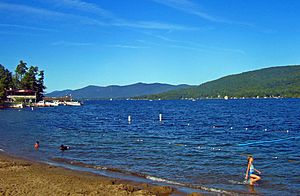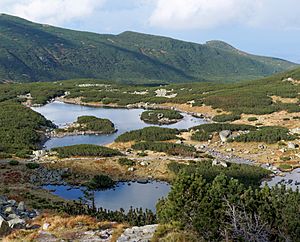Trophic state index facts for kids
The trophic state index (TSI) helps us measure how many nutrients, like nitrogen and phosphorus, are in a lake or other body of water. More nutrients usually mean more plant growth, which changes the lake's "trophic level." The TSI gives us a good idea of how healthy a lake's ecosystem is.
Contents
Carlson's Lake Health Index
Carlson's Index is a special type of Trophic State Index. The United States Environmental Protection Agency uses it. The trophic state describes the total amount of living stuff, or biomass, in a water body when it's measured. Carlson's index uses the amount of algae to figure out a lake's health status.
How the Index is Measured
Three main things help us calculate the Carlson Index: chlorophyll (the green stuff in plants), total phosphorus, and Secchi depth. Chlorophyll is usually the best way to measure, as it shows how much algae is really there. Phosphorus can be better in summer. Secchi depth is the least accurate but easiest and cheapest. It measures how clear the water is. This helps us see how much stuff is floating or dissolved in the water, which can tell us about the biomass.
Lake Health Classes
Lakes can be put into one of three main groups: oligotrophic, mesotrophic, or eutrophic. Lakes with very extreme conditions can also be called hyperoligotrophic or hypereutrophic. Each type of lake has different kinds of fish and other living things. If there's too much algae in a lake, it can cause problems. When the algae dies and breaks down, it uses up the oxygen in the water, which can kill many fish.
Oligotrophic Lakes: Clear and Clean
Oligotrophic lakes have very little or no water plants. Their water is very clear. They have low levels of nutrients. This water is often good enough to drink. The deeper parts of these lakes usually have lots of oxygen. This means many different fish species can live there. For example, lake trout need cold water with plenty of oxygen. Deeper lakes often have more oxygen because they hold more cold, dense water.
You often find oligotrophic lakes in cold places. They are usually on top of hard rocks like granitic bedrock.
Mesotrophic Lakes: Moderately Healthy
Mesotrophic lakes are lakes that have a medium amount of living things. They usually have clear water with some underwater plants. They also have medium levels of nutrients.
The word mesotrophic can also describe land areas. Mesotrophic soils have moderate amounts of nutrients.
Eutrophic Lakes: Full of Life (and Sometimes Too Much)
Eutrophic lakes have a lot of living things, including many algae blooms. They have many nutrients and can support lots of water plants and algae. Usually, either water plants or algae will be the main living thing in the lake. If there are many water plants, the water tends to be clear. If there is a lot of algae, the water tends to look darker. Algae make oxygen through photosynthesis, which helps fish and plants. But sometimes, too much algae grows. This "algae bloom" can use up all the oxygen in the water when the algae dies, which can kill fish. This process, called eutrophication, can happen naturally or because of human actions.
The word eutrophic comes from the Greek word eutrophos, meaning well-nourished. Eu means good, and trephein means to nourish.
Hypereutrophic Lakes: Too Much of a Good Thing
Hypereutrophic lakes are extremely rich in nutrients. They often have very large algae blooms and water that is not clear at all. You can usually see less than three feet deep into hypereutrophic lakes. They also have very high levels of chlorophyll and phosphorus. These huge algae blooms can also lower oxygen levels, creating "dead zones" under the water's surface where nothing can live.
What Changes a Lake's Health Index?
Both natural events and human actions can affect a lake's Trophic Index. A lake in an area with naturally rich soil might be eutrophic on its own. But nutrients that flow into water bodies, like runoff from farms, fertilizers from homes, and sewage, will all increase the amount of algae. This can easily turn a clear, oligotrophic lake into a hypereutrophic one.
Managing Lake Health
Different people often want different things for a lake's health. For example, duck hunters might want a lake to be eutrophic because it supports many ducks. People who live nearby, however, might want the same lake to be oligotrophic, as it's nicer for swimming and boating. Groups that manage natural resources are usually in charge of balancing these different needs and deciding what a lake's trophic index should be.
Related pages
See also
 In Spanish: Índice de estado trófico para niños
In Spanish: Índice de estado trófico para niños




